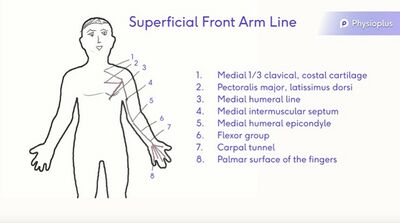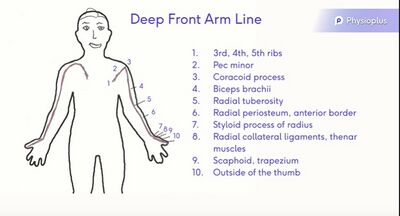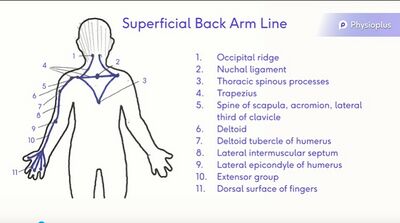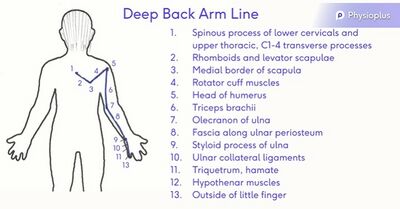Upper Extremity Myofascial Chains: Difference between revisions
Carin Hunter (talk | contribs) m (Protected "Upper Extremity Myofascial Chains": Course Page ([Edit=Allow only autoconfirmed users] (indefinite) [Move=Allow only autoconfirmed users] (indefinite))) |
No edit summary |
||
| (35 intermediate revisions by 4 users not shown) | |||
| Line 1: | Line 1: | ||
<div class="editorbox"> '''Original Editor '''- [[User:Carin Hunter|Carin Hunter]] based on the course by [https://members.physio-pedia.com/course_tutor/rina-pandya/ Rina Pandya]<br> '''Top Contributors''' - {{Special:Contributors/{{FULLPAGENAME}}}}</div> | |||
== Introduction == | |||
Historically, skeletal [[Muscle|muscles]] have been viewed as independent structures. However, recent research increasingly suggests that skeletal muscles work together as part of interconnected anatomical chains - i.e. myofascial chains.<ref>Burk C, Perry J, Lis S, Dischiavi S, Bleakley C. [https://journals.humankinetics.com/view/journals/jsr/29/5/article-p650.xml Can myofascial interventions have a remote effect on ROM? A systematic review and meta-analysis.] Journal of sport rehabilitation. 2019 Oct 18;29(5):650-6.</ref><ref>Dischiavi SL, Wright AA, Hegedus EJ, Bleakley CM. [https://www.sciencedirect.com/science/article/pii/S0306987717304243 Biotensegrity and myofascial chains: A global approach to an integrated kinetic chain.] Medical hypotheses. 2018 Jan 1;110:90-6.</ref><ref name=":1">Bordoni B, Myers T. [https://www.ncbi.nlm.nih.gov/pmc/articles/PMC7096016/ A review of the theoretical fascial models: biotensegrity, fascintegrity, and myofascial chains.] Cureus. 2020 Feb;12(2).</ref><ref>Ajimsha MS, Shenoy PD, Gampawar N. [https://www.bodyworkmovementtherapies.com/article/S1360-8592(20)30148-0/fulltext#secsectitle0040 Role of fascial connectivity in musculoskeletal dysfunctions: A narrative review.] Journal of Bodywork and Movement Therapies. 2020 Oct 1;24(4):423-31.</ref> | |||
A myofascial chain is essentially a line of connective tissue that runs through the body. These chains enable movement and force transmission<ref name=":1" /> and help the body to move as a unit. They can, however, also cause [[Myofascial Pain|pain]] and structural weakness.<ref name=":0" /> Thus, by understanding myofascial chains, you may be better able to understand injuries and movement limitations. | |||
A number of theories about myofascial chains have been proposed. In 2013, Meyers suggested that there are 12 myofascial meridians in the body.<ref>Kazakos D, Liapis A, Mylonas K, Angelopoulos P, Koubetsos A, Tsepis E, Fousekis K. [https://europepmc.org/article/pmc/pmc7708005 Treatment of scalene muscles with the Ergon technique can lead to greater improvement in hip abduction range of motion than local hip adductor treatment: a study on deep front line connectivity.] Journal of Physical Therapy Science. 2020;32(11):706-9.</ref> A systematic review by Wilke and Krause<ref>Wilke J, Krause F. [https://onlinelibrary.wiley.com/doi/abs/10.1002/ca.23424 Myofascial chains of the upper limb: a systematic review of anatomical studies.] Clinical Anatomy. 2019 Oct;32(7):934-40.</ref> found strong evidence to support the existence of three myofascial chains. This page focuses on four myofascial chains of the upper limb,<ref name=":0" /> which are described in more detail below: | |||
# Superficial front arm line (Figure 1) | |||
# Deep front arm line (Figure 2) | |||
# Superficial back arm line (Figure 3) | |||
# Deep back arm line (Figure 4) | |||
== Superficial Front Arm Line == | |||
This line travels down the anterior and medial side of the arm.<ref name=":0">Pandya R. Upper Extremity Myofascial Chains Course. Plus , 2021.</ref> | |||
# [[File:Superficial Front Arm Line.jpg|thumb|400x400px|Figure 1. Superficial front arm line.]]Medial third of the [[Clavicula|clavicle]], [[Ribs|coastal cartilage]] | |||
# [[Pectoralis major|Pectoralis major,]] [[Latissimus Dorsi Muscle|latissimus dorsi]] | |||
# Medial [[Humerus|humeral]] line | |||
# Medial intermuscular septum | |||
# Medial humeral epicondyle | |||
# Flexor group | |||
# [[Carpal Tunnel Syndrome|Carpal tunnel]] | |||
# Palmar surface of the fingers | |||
== Deep Front Arm Line == | |||
This line travels down the radial side of the arm. Clinical symptoms associated with this chain might include tingling / numbness on the lateral side of the thumb, which could be associated with [[Medial Epicondyle Tendinopathy|golfer's elbow]].<ref name=":0" /> | |||
# [[File:Deep Front Arm Line.jpg|thumb|400x400px|Figure 2. Deep front arm line.]]3rd, 4th and 5th [[ribs]] | |||
# [[Pectoralis Minor|Pectoralis minor]] | |||
# [[Scapula|Coracoid]] process | |||
# [[Biceps Brachii]] | |||
# Radial tuberosity | |||
# Anterior border of radial periosteum | |||
# Styloid process of [[radius]] | |||
# Radial collateral ligaments and thenar muscles | |||
# [[Scaphoid]] and trapezuim | |||
# Outside of the thumb | |||
== Superficial Back Arm Line == | |||
This line travels along the radial side of the arm. Clinical symptoms associated with dysfunction in this line include: rounded shoulders / [[Thoracic Hyperkyphosis|kyphotic spine]] (i.e. office workers) with hypomobility, neck pain and [[Headache|headaches]]. [[Trigger Points|Trigger points]] may be present in the periscapular area and along the extensor aspect of the arm. There may also be signs of [[Carpal Tunnel Syndrome|carpal tunnel syndrome]].<ref name=":0" /> | |||
# [[File:Superficial Back Arm Line.jpg|thumb|400x400px|Figure 3. Superficial back arm line.]][[Occipital Bone|Occipital ridge]] | |||
# Nuchal ligament | |||
# [[Thoracic Vertebrae|Thoracic spinous process]] | |||
# [[Trapezius]] | |||
# Spine of scapula, acromion, lateral third of clavicle | |||
# [[Deltoid]] | |||
# Deltoid tubercle of [[humerus]] | |||
# Lateral intramuscular septum | |||
# Lateral epicondyle of humerus | |||
# Extensor group | |||
# Dorsal surface of fingers | |||
== Deep Back Arm Line == | |||
This line travels along the ulnar border of the arm. Patients might complain of "bone" pain on the medial border of the scapula. They may also have a [[Forward Head Posture|forward head position]] with a hypomobile ridge along the cervicothoracic junction.<ref name=":0" /> | |||
# [[File:Deep Back Arm Line (2).jpg|thumb|400x400px|Figure 4. Deep back arm line.]][[Cervical Vertebrae|Spinous process of lower cervicals]] and upper thoracic spine, C1-4 transverse processes | |||
# [[Rhomboids]] and [[Levator Scapulae|levator scapula]] | |||
# Medial border of scapula | |||
# [[Rotator Cuff|Rotator cuff muscles]] | |||
# Head of humerus | |||
# [[Triceps brachii]] | |||
# Olecranon of [[ulna]] | |||
# [[Fascia]] along ulnar periosteum | |||
# Styloid process of ulna | |||
# Ulnar collateral ligaments | |||
# [[Triquetrum]], [[hamate]] | |||
# Hypothenar muscles | |||
# Outside of little finger | |||
== Stabilisation Tracts == | |||
=== 1. Back arm line === | |||
# Latissimus dorsi | |||
# [[Thoracolumbar Fascia|Thoracolumbar fascia]] | |||
# Sacral fascia contralateral to thoracolumbar fascia | |||
# [[Gluteus Maximus|Gluteus maximus]] contralateral to thoracolumbar fascia | |||
# [[Vastus Lateralis|Vastus lateralis]]<ref name=":2">Ward P. SFMA and Anatomy Trains: Concepts For Assessment and Treatment [Internet]. Sports Rehab Expert [accessed 29 November 2021]. Available from: https://www.sportsrehabexpert.com/public/472.cfm</ref> | |||
=== 2. Front arm line === | |||
# Pectoralis major | |||
# [[External Abdominal Oblique|External oblique]] | |||
# [[Adductor Longus|Adductor longus]] contralateral to external oblique | |||
# [[Gracilis]] contralateral to external oblique | |||
# [[Pes Anserinus Bursitis|Pes anserine]] contralateral to external oblique | |||
# [[Tibia|Tibial]] [[periosteum]] contralateral to external oblique<ref name=":2" /> | |||
== References == | |||
[[Category:Plus Content]] | |||
[[Category:Course Pages]] | |||
<references /> | |||
[[Category:Musculoskeletal/Orthopaedics]] | |||
Latest revision as of 18:21, 13 January 2023
Top Contributors - Jess Bell, Carin Hunter, Kim Jackson, Lucinda hampton and Robin Tacchetti
Introduction[edit | edit source]
Historically, skeletal muscles have been viewed as independent structures. However, recent research increasingly suggests that skeletal muscles work together as part of interconnected anatomical chains - i.e. myofascial chains.[1][2][3][4]
A myofascial chain is essentially a line of connective tissue that runs through the body. These chains enable movement and force transmission[3] and help the body to move as a unit. They can, however, also cause pain and structural weakness.[5] Thus, by understanding myofascial chains, you may be better able to understand injuries and movement limitations.
A number of theories about myofascial chains have been proposed. In 2013, Meyers suggested that there are 12 myofascial meridians in the body.[6] A systematic review by Wilke and Krause[7] found strong evidence to support the existence of three myofascial chains. This page focuses on four myofascial chains of the upper limb,[5] which are described in more detail below:
- Superficial front arm line (Figure 1)
- Deep front arm line (Figure 2)
- Superficial back arm line (Figure 3)
- Deep back arm line (Figure 4)
Superficial Front Arm Line[edit | edit source]
This line travels down the anterior and medial side of the arm.[5]
- Medial third of the clavicle, coastal cartilage
- Pectoralis major, latissimus dorsi
- Medial humeral line
- Medial intermuscular septum
- Medial humeral epicondyle
- Flexor group
- Carpal tunnel
- Palmar surface of the fingers
Deep Front Arm Line[edit | edit source]
This line travels down the radial side of the arm. Clinical symptoms associated with this chain might include tingling / numbness on the lateral side of the thumb, which could be associated with golfer's elbow.[5]
- 3rd, 4th and 5th ribs
- Pectoralis minor
- Coracoid process
- Biceps Brachii
- Radial tuberosity
- Anterior border of radial periosteum
- Styloid process of radius
- Radial collateral ligaments and thenar muscles
- Scaphoid and trapezuim
- Outside of the thumb
Superficial Back Arm Line[edit | edit source]
This line travels along the radial side of the arm. Clinical symptoms associated with dysfunction in this line include: rounded shoulders / kyphotic spine (i.e. office workers) with hypomobility, neck pain and headaches. Trigger points may be present in the periscapular area and along the extensor aspect of the arm. There may also be signs of carpal tunnel syndrome.[5]
- Occipital ridge
- Nuchal ligament
- Thoracic spinous process
- Trapezius
- Spine of scapula, acromion, lateral third of clavicle
- Deltoid
- Deltoid tubercle of humerus
- Lateral intramuscular septum
- Lateral epicondyle of humerus
- Extensor group
- Dorsal surface of fingers
Deep Back Arm Line[edit | edit source]
This line travels along the ulnar border of the arm. Patients might complain of "bone" pain on the medial border of the scapula. They may also have a forward head position with a hypomobile ridge along the cervicothoracic junction.[5]
- Spinous process of lower cervicals and upper thoracic spine, C1-4 transverse processes
- Rhomboids and levator scapula
- Medial border of scapula
- Rotator cuff muscles
- Head of humerus
- Triceps brachii
- Olecranon of ulna
- Fascia along ulnar periosteum
- Styloid process of ulna
- Ulnar collateral ligaments
- Triquetrum, hamate
- Hypothenar muscles
- Outside of little finger
Stabilisation Tracts[edit | edit source]
1. Back arm line[edit | edit source]
- Latissimus dorsi
- Thoracolumbar fascia
- Sacral fascia contralateral to thoracolumbar fascia
- Gluteus maximus contralateral to thoracolumbar fascia
- Vastus lateralis[8]
2. Front arm line[edit | edit source]
- Pectoralis major
- External oblique
- Adductor longus contralateral to external oblique
- Gracilis contralateral to external oblique
- Pes anserine contralateral to external oblique
- Tibial periosteum contralateral to external oblique[8]
References[edit | edit source]
- ↑ Burk C, Perry J, Lis S, Dischiavi S, Bleakley C. Can myofascial interventions have a remote effect on ROM? A systematic review and meta-analysis. Journal of sport rehabilitation. 2019 Oct 18;29(5):650-6.
- ↑ Dischiavi SL, Wright AA, Hegedus EJ, Bleakley CM. Biotensegrity and myofascial chains: A global approach to an integrated kinetic chain. Medical hypotheses. 2018 Jan 1;110:90-6.
- ↑ 3.0 3.1 Bordoni B, Myers T. A review of the theoretical fascial models: biotensegrity, fascintegrity, and myofascial chains. Cureus. 2020 Feb;12(2).
- ↑ Ajimsha MS, Shenoy PD, Gampawar N. Role of fascial connectivity in musculoskeletal dysfunctions: A narrative review. Journal of Bodywork and Movement Therapies. 2020 Oct 1;24(4):423-31.
- ↑ 5.0 5.1 5.2 5.3 5.4 5.5 Pandya R. Upper Extremity Myofascial Chains Course. Plus , 2021.
- ↑ Kazakos D, Liapis A, Mylonas K, Angelopoulos P, Koubetsos A, Tsepis E, Fousekis K. Treatment of scalene muscles with the Ergon technique can lead to greater improvement in hip abduction range of motion than local hip adductor treatment: a study on deep front line connectivity. Journal of Physical Therapy Science. 2020;32(11):706-9.
- ↑ Wilke J, Krause F. Myofascial chains of the upper limb: a systematic review of anatomical studies. Clinical Anatomy. 2019 Oct;32(7):934-40.
- ↑ 8.0 8.1 Ward P. SFMA and Anatomy Trains: Concepts For Assessment and Treatment [Internet]. Sports Rehab Expert [accessed 29 November 2021]. Available from: https://www.sportsrehabexpert.com/public/472.cfm










